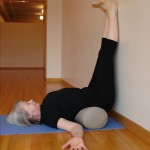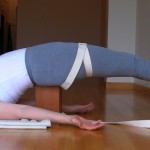On Tuesday night, in the last two classes I taught for the summer, we put the props away – no mats, no blankets, no straps, no bolsters, no chip foams.
Just us, the floor, the walls and a couple of wood bricks each.
The oak floor in the Yoga on 7th studio rests on a concrete slab. When the heat is off, the slab cools down and the floor is a delight under foot, and even better to lie down on.
Yes, even here on the wet West Coast, summer yoga is different.
In an airy place, early in the day, the active, heating poses – standing work, hand balances, backbends – still have their allure.
But at the end of a working day, after a hot trip home, what you want is a little cool relief.
Here are five of my favorite ways to cool down.
Each one of them can be done as a stand alone practice, or you can string them into a sequence. Click on the pose names where there’s a link, and you’ll find a full explanation of each one.
If the lovely-please-don’t-go-away-I’m-not-complaining hot weather continues, I’ll post the two missing poses – Uttanasana with head rest and Supta Baddha Konasana – in the next few weeks.
 1. Uttanasana (standing forward bend) with head resting on a chair.
1. Uttanasana (standing forward bend) with head resting on a chair.
If time is short, you can go straight from there into Savasana (relaxation pose) with your feet up on the chair.
2. Supta Baddha Konaasana (reclining bound angle).
As little as five minutes will begin to cool you down. If you have the luxury of a longer stay, try setting a timer for 10 or 20 minutes.
 3. Come back to neutral with child’s pose over a bolster.
3. Come back to neutral with child’s pose over a bolster.
A continuation of forward bend that adds the cooling darkness of closed eyes.
 4. Viparita Karani,
4. Viparita Karani,
The variation in which you cross your shins, as in Sukkhasanana (easy cross-legs position) and let them rest against the wall is especially restful and cooling.
 5. Supported Setubanda. (bridge pose)
5. Supported Setubanda. (bridge pose)
No, you don’t have to lose your head or your feet to do this pose. Sorry, but the picture just doesn’t work as a square. Click the link and you’ll see it the way it’s supposed to be.
As you stay in this pose, you’ll find your mind cooling and being coming quiet, as your body cools down.
6. Savasana:
Use an eye bag if possible. Support your head if you need to, and consider a bolster under your knees or whatever other prop lets you completely release. Or go basic if your floor is cool, and let yourself spread out like a cat trying to find as much cool surface as possible under its fur.



